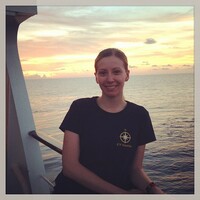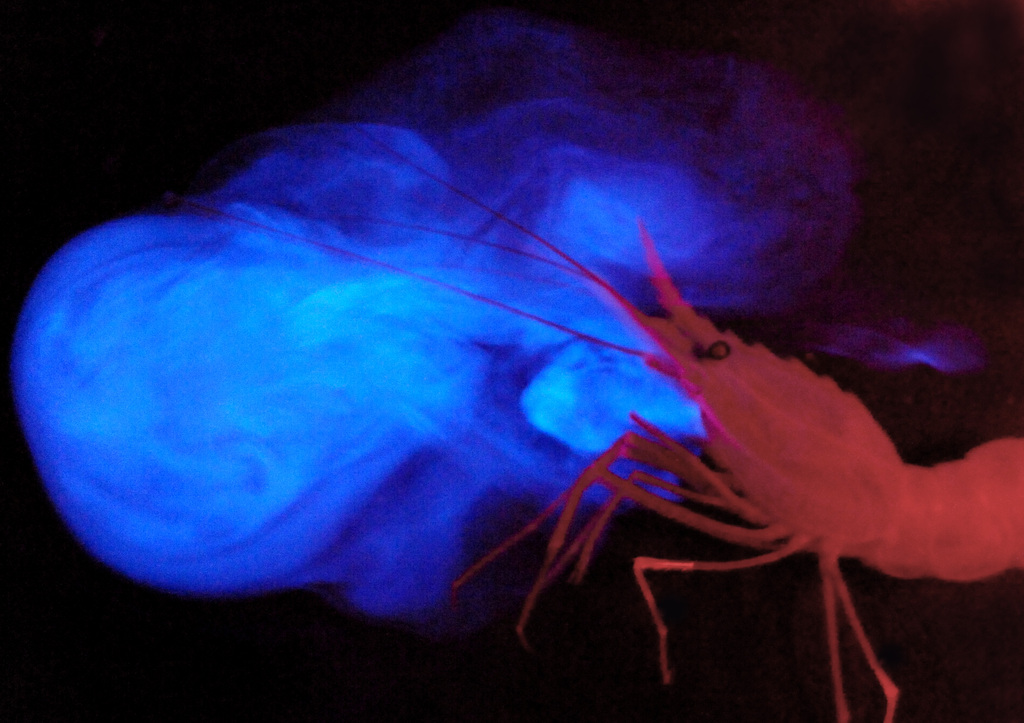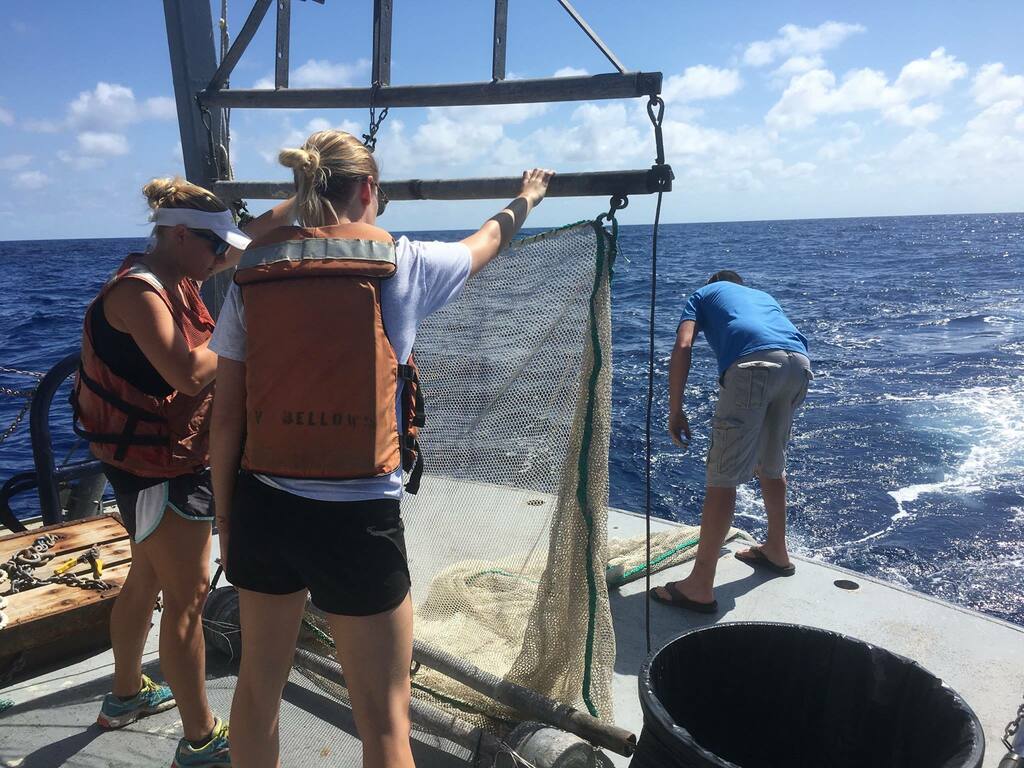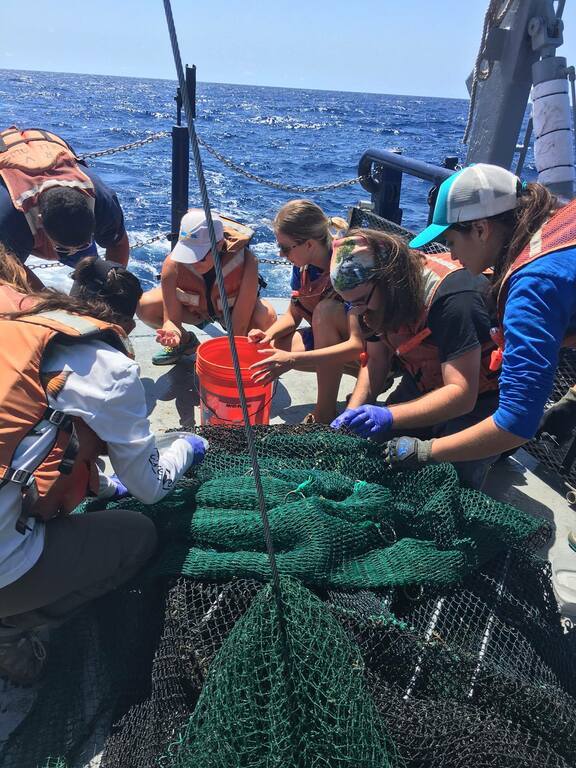Blog:
An interview with Danielle DeLeo
2017, October 30
Posted by Veronica Radice
My past research was focused on anthropogenic impacts to deep, cold-water coral communities with particular emphasis on the effects imposed by the 2010 Deep-water Horizon oil spill disaster in the Gulf of Mexico. I'm interested in characterizing stress responses at the cellular level using high-throughput sequencing and transcriptomics. My current postdoctoral research at Florida International University is focused on understanding how different modes of bioluminescence evolved in deep-sea crustaceans, as well as characterizing different types of autogenic, bioluminescent organs and visual pathways via a combination of phylogenetic and transcriptomic methods.
Early Career Scientist: Danielle DeLeo
How do you pronounce “mesophotic” – ‘mee-so’ or ‘meh-so’ -photic?
‘mee-so’ but I have found myself saying it both ways depending on what area of the U.S. I happen to be in...
Are you more interested in charismatic megafauna or scouring the benthos for cool creatures?
I really love the exploratory aspect of deep-sea science, visiting new regions of the benthos and discovering new communities. It comes with the territory given the deep sea is still so poorly characterized relative to nearshore ecosystems. With that said, I dedicated most of my career thus far studying corals which I consider charismatic megafauna, although the deeper species can be somewhat more cryptic and mysterious than their shallow-water counterparts.
What is your primary research interest, and how does it link with the mesophotic zone?
I am currently working on a collaborative, NSF-funded project under the guidance of Heather Bracken-Grissom, to characterize the visual systems of deep-sea decapod crustaceans and understand how different modes of bioluminescence evolved in these organisms. Several of the pelagic shrimp species we work with undergo diel vertical migrations, one of the largest animal migrations on earth in terms of biomass. These migrating organisms typically occupy deep, light-limiting (or absent) depths during the day to avoid predation, and trek to shallower or mesophotic depths during the night time to feed. These shrimp migrate from the benthos fairly far off the coast in the Gulf of Mexico where you will find coral communities, mostly deep sea species, but these shrimp species exist in the Florida Straits as well. A lot of the shrimp spend their days in 500-1000 m depths and migrate to 100-300 m at night. While all of the species we are studying as part of this project possess the ability to secrete bioluminescent fluid, primarily as a defense mechanism, it appears that only those that migrate possess autogenic bioluminescent light-emitting organs (photophores). The bioluminescent organs that these shrimp possess are believed to function in counter-illumination throughout diel migration through the mesophotic zone, among other things.
Describe the location of your main (or most interesting) study site and how it fits in with your research questions.
Most of my research has been carried out in the Gulf of Mexico (GoM), although I have recently done field work in the Florida Straits. My field training began in the GoM for my PhD as my initial projects were focused on the impacts from the 2010 Deepwater Horizon Oil Spill disaster. Cold-water communities in the area were impacted in the aftermath of the spill and unfortunately baseline data on pre-spill conditions was limited. Funding and resources, like ship-time and ROVs, to investigate the impacts of this environmental disaster provided enhanced opportunities to explore and study both the basics of cold-water coral biology and how they respond to anthropogenic disturbances. Because it is harder to physically access deep-water environments, I think it is easy to forget that these communities are affected by similar anthropogenic threats like climate change, ocean acidification and resource exploitation.
What is your primary means of accessing mesophotic depths to conduct your research (e.g. ROV, SCUBA, rebreather, submersible) and what were the main challenges to overcome?
A lot of my previous research on cold-water corals was done using ROV’s and the Deep-submergence vehicle (DSV) Alvin. I was fortunate to dive twice in the DSV Alvin to visit and collect samples from coral communities in the GoM, though the ‘human factor’ limits the timing of our efforts in the submersible and increases the risks associated with sampling in high-pressure environments- mechanical issues are not uncommon. ROVs are invaluable to deep-sea research and allow for more continuous sampling operations with reduced risk. However, as with any kind of fieldwork, diving with these vehicles is extremely dependent on weather conditions, where high seas and storms can limit, or completely eliminate, our sampling efforts while still consuming our project/fieldwork funding. Steaming back to port to outrun a hurricane is not good for project morale! Data and sampling for my current research projects were primarily collected via pelagic mid-water trawling- towing large nets suspended on an A-frame off the back of a ship, the deployment of which, as you can imagine, is also highly weather dependent. While similarly constrained by mechanical issues that can lead to lost sampling days, it also comes with it’s own unique challenges- namely trawling for hours only to have the net come up (near) empty.
What do you remember from your very first exposure to coral reef or mesophotic fieldwork?
My first experience with coral reefs, and fieldwork in general, was during an undergraduate study abroad experience in Curaçao. Although I was told the reefs in the area had declined over the years, I still remember being fascinated by them and in awe of the diversity of fauna they supported. The experience made me decide to pursue a graduate degree. I also remember noticing the resiliency of octocorals in the more impacted areas of the reef, a memory that later inspired my graduate research.
What new skill(s) have you learned during your research and what is one thing (skill, program, advice, etc.) that you wish you learned earlier in your science journey?
Throughout my PhD, and more so now during my postdoc, I have been acquiring experience utilizing bioinformatics tools to answer a variety of questions for non-model invertebrates. These skills are essential to answering a variety of questions, in my case ranging from coral stress responses at the molecular level to characterizing the visual pathways of bioluminescent crustaceans. Earlier (and more thorough) exposure to this type of training would have been extremely useful!
How do you keep current with an endless stream of research coming out (or any favorite science website or blogs that you follow)?
Honestly, I am not sure anyone is able to stay current- there is so much exciting research going on. I think conferences are one of the best ways to do this, so I make it a point to attend as many as I can. I also have various Google Scholar alerts set with keywords related to my research areas, so I get weekly emails of relevant publications, and follow colleagues and fellow scientists on Twitter to get notified about the latest/exciting research. I try to find a balance between trying to stay up to date on research related to my current projects, interests and study system, and exciting and novel research coming out in different, but related, fields. I find inspiration from techniques and concepts not traditionally applied or commonly used on non-model organisms.



